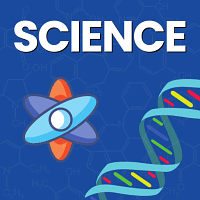Class 4 Exam > Class 4 Questions > The energy used for cycling comes froma)the c...
Start Learning for Free
The energy used for cycling comes from
- a)the chemical energy of food.
- b)the heat energy of our body.
- c)sound energy.
- d)light energy.
Correct answer is option 'A'. Can you explain this answer?
Verified Answer
The energy used for cycling comes froma)the chemical energy of food.b)...
We get energy in the form of chemical energy from digested food to do work.
 This question is part of UPSC exam. View all Class 4 courses
This question is part of UPSC exam. View all Class 4 courses
Most Upvoted Answer
The energy used for cycling comes froma)the chemical energy of food.b)...
The energy used for cycling comes from the chemical energy of food.
The process of cycling requires a constant supply of energy to power the muscles and enable movement. This energy comes from the chemical energy stored in the food we consume. Let's explore this in more detail:
1. The Digestive System:
When we eat food, it goes through a process called digestion in our digestive system. During digestion, the food is broken down into smaller molecules, including carbohydrates, fats, and proteins. These molecules can be used by our body to release energy.
2. Energy Production:
Once the food molecules are broken down, they enter the bloodstream and are transported to the cells in our body. Inside the cells, these molecules undergo a series of chemical reactions known as cellular respiration.
During cellular respiration, the carbohydrates, fats, and proteins are further broken down to release energy in the form of a molecule called adenosine triphosphate (ATP). ATP is the primary source of energy for cellular processes, including muscle contraction during cycling.
3. ATP and Muscle Contraction:
Muscle contraction is a crucial component of cycling. When we pedal, our leg muscles contract and relax in a coordinated manner, propelling the bicycle forward. This contraction requires energy, which is provided by ATP.
As the muscles contract, ATP is broken down into adenosine diphosphate (ADP) and inorganic phosphate (Pi), releasing energy in the process. This energy powers the cycling motion.
4. Continuous Energy Supply:
Cycling is an endurance activity that requires a continuous supply of energy. This is why it is important to maintain a balanced diet and consume enough food to provide the necessary fuel for the body.
Carbohydrates, such as pasta, rice, and fruits, are a primary source of energy during exercise. Fats also play a role in providing energy, especially during longer cycling sessions. Proteins are important for muscle repair and recovery after cycling.
Conclusion:
In summary, the energy used for cycling comes from the chemical energy stored in the food we eat. Through the process of digestion and cellular respiration, the carbohydrates, fats, and proteins in our food are converted into ATP, which fuels the muscle contractions required for cycling. Therefore, option 'A' - the chemical energy of food, is the correct answer.
The process of cycling requires a constant supply of energy to power the muscles and enable movement. This energy comes from the chemical energy stored in the food we consume. Let's explore this in more detail:
1. The Digestive System:
When we eat food, it goes through a process called digestion in our digestive system. During digestion, the food is broken down into smaller molecules, including carbohydrates, fats, and proteins. These molecules can be used by our body to release energy.
2. Energy Production:
Once the food molecules are broken down, they enter the bloodstream and are transported to the cells in our body. Inside the cells, these molecules undergo a series of chemical reactions known as cellular respiration.
During cellular respiration, the carbohydrates, fats, and proteins are further broken down to release energy in the form of a molecule called adenosine triphosphate (ATP). ATP is the primary source of energy for cellular processes, including muscle contraction during cycling.
3. ATP and Muscle Contraction:
Muscle contraction is a crucial component of cycling. When we pedal, our leg muscles contract and relax in a coordinated manner, propelling the bicycle forward. This contraction requires energy, which is provided by ATP.
As the muscles contract, ATP is broken down into adenosine diphosphate (ADP) and inorganic phosphate (Pi), releasing energy in the process. This energy powers the cycling motion.
4. Continuous Energy Supply:
Cycling is an endurance activity that requires a continuous supply of energy. This is why it is important to maintain a balanced diet and consume enough food to provide the necessary fuel for the body.
Carbohydrates, such as pasta, rice, and fruits, are a primary source of energy during exercise. Fats also play a role in providing energy, especially during longer cycling sessions. Proteins are important for muscle repair and recovery after cycling.
Conclusion:
In summary, the energy used for cycling comes from the chemical energy stored in the food we eat. Through the process of digestion and cellular respiration, the carbohydrates, fats, and proteins in our food are converted into ATP, which fuels the muscle contractions required for cycling. Therefore, option 'A' - the chemical energy of food, is the correct answer.
Attention Class 4 Students!
To make sure you are not studying endlessly, EduRev has designed Class 4 study material, with Structured Courses, Videos, & Test Series. Plus get personalized analysis, doubt solving and improvement plans to achieve a great score in Class 4.

|
Explore Courses for Class 4 exam
|

|
Similar Class 4 Doubts
The energy used for cycling comes froma)the chemical energy of food.b)the heat energy of our body.c)sound energy.d)light energy.Correct answer is option 'A'. Can you explain this answer?
Question Description
The energy used for cycling comes froma)the chemical energy of food.b)the heat energy of our body.c)sound energy.d)light energy.Correct answer is option 'A'. Can you explain this answer? for Class 4 2024 is part of Class 4 preparation. The Question and answers have been prepared according to the Class 4 exam syllabus. Information about The energy used for cycling comes froma)the chemical energy of food.b)the heat energy of our body.c)sound energy.d)light energy.Correct answer is option 'A'. Can you explain this answer? covers all topics & solutions for Class 4 2024 Exam. Find important definitions, questions, meanings, examples, exercises and tests below for The energy used for cycling comes froma)the chemical energy of food.b)the heat energy of our body.c)sound energy.d)light energy.Correct answer is option 'A'. Can you explain this answer?.
The energy used for cycling comes froma)the chemical energy of food.b)the heat energy of our body.c)sound energy.d)light energy.Correct answer is option 'A'. Can you explain this answer? for Class 4 2024 is part of Class 4 preparation. The Question and answers have been prepared according to the Class 4 exam syllabus. Information about The energy used for cycling comes froma)the chemical energy of food.b)the heat energy of our body.c)sound energy.d)light energy.Correct answer is option 'A'. Can you explain this answer? covers all topics & solutions for Class 4 2024 Exam. Find important definitions, questions, meanings, examples, exercises and tests below for The energy used for cycling comes froma)the chemical energy of food.b)the heat energy of our body.c)sound energy.d)light energy.Correct answer is option 'A'. Can you explain this answer?.
Solutions for The energy used for cycling comes froma)the chemical energy of food.b)the heat energy of our body.c)sound energy.d)light energy.Correct answer is option 'A'. Can you explain this answer? in English & in Hindi are available as part of our courses for Class 4.
Download more important topics, notes, lectures and mock test series for Class 4 Exam by signing up for free.
Here you can find the meaning of The energy used for cycling comes froma)the chemical energy of food.b)the heat energy of our body.c)sound energy.d)light energy.Correct answer is option 'A'. Can you explain this answer? defined & explained in the simplest way possible. Besides giving the explanation of
The energy used for cycling comes froma)the chemical energy of food.b)the heat energy of our body.c)sound energy.d)light energy.Correct answer is option 'A'. Can you explain this answer?, a detailed solution for The energy used for cycling comes froma)the chemical energy of food.b)the heat energy of our body.c)sound energy.d)light energy.Correct answer is option 'A'. Can you explain this answer? has been provided alongside types of The energy used for cycling comes froma)the chemical energy of food.b)the heat energy of our body.c)sound energy.d)light energy.Correct answer is option 'A'. Can you explain this answer? theory, EduRev gives you an
ample number of questions to practice The energy used for cycling comes froma)the chemical energy of food.b)the heat energy of our body.c)sound energy.d)light energy.Correct answer is option 'A'. Can you explain this answer? tests, examples and also practice Class 4 tests.

|
Explore Courses for Class 4 exam
|

|
Suggested Free Tests
Signup for Free!
Signup to see your scores go up within 7 days! Learn & Practice with 1000+ FREE Notes, Videos & Tests.

























